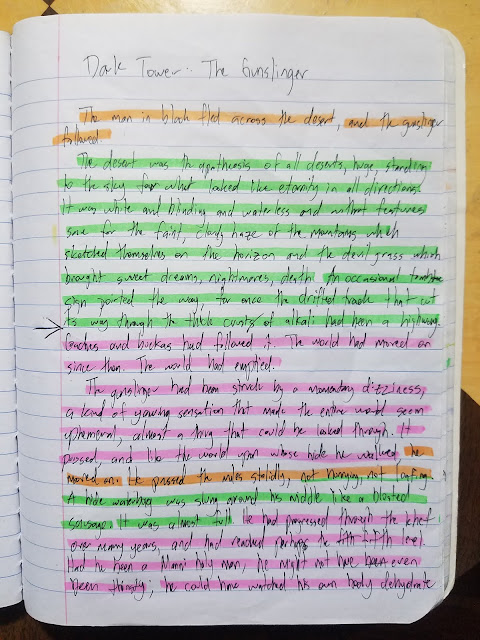As a refresher from my copywork blogpost (click here to read the full post), here is the color coding on the highlights:
- Orange for Action beats
- Green for Descriptions
- No highlights for Dialogue
- Yellow for Summary/Transition
- Blue for Thoughts
- Pink for Authorial/Narrator Intrusion
- Purple for Exposition
It’s been a while since I read The Gunslinger by Stephen King. I assumed that the first scene would be filled with concrete beats, but found out that it was mostly composed of abstract beats. Not much of telling exposition, but of the narrator speaking on behalf of the gunslinger.
I will be trying out a new format with my scene analysis. Concrete and abstract beats will be bulleted as you can see below.
- CONCRETE: The first line grounding us in the scene. The narrator painting us a picture of the wastelands.
- ABSTRACT: The narrator mentioning that the world has moved on and emptied. The narrator revealing that the gunslinger is struck by dizziness which passes eventually.
- CONCRETE: The gunslinger pressing on. The narrator focusing on the waterbag he carried.
- ABSTRACT: The gunslinger thinking on his thirst.
- ABSTRACT: The gunslinger thinking on his thirst (continued).
- CONCRETE: The narrator focusing on the guns he carried.
- CONCRETE: The narrator showing what the gunslinger is wearing.
- ABSTRACT: The narrator mentioning what he’s missing: his hat and his horn.
- CONCRETE: The gunslinger reaching the man in black’s campfire.
- ABSTRACT: The gunslinger thinking about the story of devil-grass
- CONCRETE: The gunslinger studying the campfire and eating a scrap of bacon
- ABSTRACT: The gunslinger thinking about his progress. The gunslinger entertaining the idea that the man in black is leaving his messages with the campfires. The narrator revealing the gunslinger’s persistence.
- CONCRETE: The gunslinger standing up and assessing his surroundings.
- ABSTRACT: The gunslinger thinking about the absence of signs or tracks from the gunslinger. The narrator hinting that the gunslinger has a “sense”, a “range-finder.”
- CONCRETE: The gunslinger drinking from the waterbag.
- ABSTRACT: The gunslinger thinking about his dizziness earlier, wondering why he thought of his friends and his horn.
- CONCRETE: The gunslinger preparing to set up camp.
- ABSTRACT: The gunslinger waiting for sundown, hoping not to see a campfire in the distance. The gunslinger thinking about what Cort would have said.
- CONCRETE: The gunslinger starting his fire, singing a song.
- ABSTRACT: The narrator remarking on childish things, like the Gunslinger’s song.
- CONCRETE: The gunslinger resting. The gunslinger observing his surroundings (the wind and the night sky).
- ABSTRACT: The narrator revealing what the gunslinger sees in the fire.
- CONCRETE: The gunslinger breathing in smoke.
- ABSTRACT: The narrator remarking how “the stars are indifferent”, that it would please the gunslinger
The first line immediately gives us the gunslinger’s motives. Also, with just a single line, we are given the protagonist, the antagonist and the setting. So packed that first line it’s unforgettable.
In this scene, though the gunslinger does not confront the man in black, he feels that he is getting closer. This is the turning point of the scene. The emotional beat changes from fatigue to hope. From negative to positive.
For tone, the narrator sounds sympathetic towards the gunslinger. There is never a derisive comment or interjection regarding him, and the narrator is wistful when it comes to recalling his old friends.
For mood, the narrator builds a sense of emptiness. The narrator does this with the following description of the wastelands: “...apotheosis of all deserts, huge, standing to the sky for what looked like eternity in all directions. ...”, and “...across the endless, screamingly monotonous purgatorial wastes...”.
Below is a graph of the narrative modes of the copied scene. This shows the rhythm between abstract and concrete beats. It scales from -3 to +3 with the following sequence respectively: Exposition (as -3), Intrusion, Thought, Transition (as 0.5), Description, Dialogue and Action (as +3).

Follow me @jonmayowriter
Click this to join my newsletter
---
Copyright Disclaimer Under Section 107 of the Copyright Act 1976, allowance is made for "fair use" for purposes such as criticism, comment, news reporting, teaching, scholarship, and research. Fair use is a use permitted by copyright statute that might otherwise be infringing. Non-profit, educational or personal use tips the balance in favor of fair use.








No comments:
Post a Comment